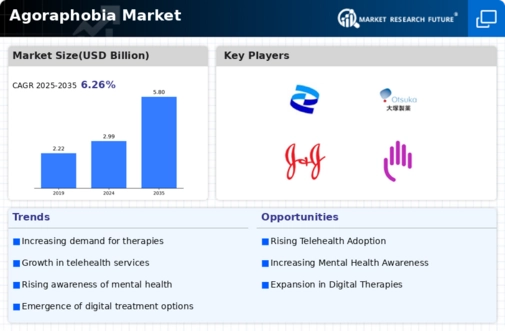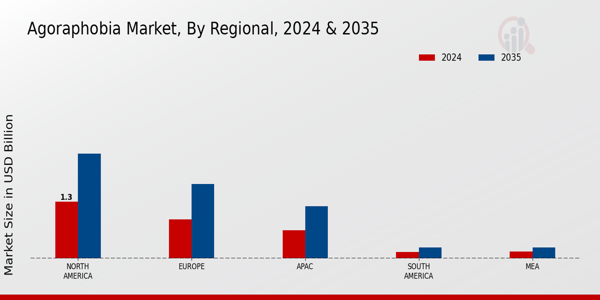Market Growth Projections
The Global Agoraphobia Market Industry is projected to experience substantial growth, with estimates indicating a market value of 2.99 USD Billion in 2024 and a potential increase to 5.8 USD Billion by 2035. The compound annual growth rate of 6.21% from 2025 to 2035 reflects the increasing demand for effective treatment options and support services. This growth trajectory suggests a robust market landscape, driven by various factors including advancements in treatment, rising awareness, and government initiatives. The future of the market appears promising, with numerous opportunities for stakeholders.
Advancements in Treatment Options
Innovations in treatment methodologies are significantly influencing the Global Agoraphobia Market Industry. The development of cognitive-behavioral therapy and pharmacological treatments has shown promising results in managing agoraphobia symptoms. For instance, the introduction of selective serotonin reuptake inhibitors has provided new avenues for patients who previously had limited options. These advancements not only improve patient outcomes but also enhance the overall market landscape. The anticipated compound annual growth rate of 6.21% from 2025 to 2035 underscores the potential for continued growth as new therapies emerge and gain acceptance.
Integration of Telehealth Services
The integration of telehealth services into mental health care is reshaping the Global Agoraphobia Market Industry. Teletherapy offers patients a convenient and accessible means to receive treatment, particularly beneficial for those with agoraphobia who may find it challenging to attend in-person sessions. The rise of digital platforms has made it easier for individuals to connect with mental health professionals, potentially increasing treatment adherence and outcomes. This shift towards telehealth is expected to play a crucial role in market growth, as it aligns with the increasing demand for flexible and accessible mental health services.
Government Support and Policy Initiatives
Government support and policy initiatives aimed at mental health care are pivotal for the Global Agoraphobia Market Industry. Many countries are implementing policies that promote mental health awareness and allocate funding for research and treatment programs. For example, increased funding for mental health services can enhance access to care for individuals suffering from agoraphobia. Such initiatives not only improve treatment availability but also encourage the development of new therapies and support systems. This supportive environment is likely to facilitate market growth, contributing to the anticipated rise in market value.
Increasing Prevalence of Anxiety Disorders
The Global Agoraphobia Market Industry is experiencing growth due to the rising prevalence of anxiety disorders, which includes agoraphobia. Recent data indicates that approximately 1.3% of the global population is affected by agoraphobia, with higher rates observed in women. This increasing incidence is likely to drive demand for therapeutic interventions and support services, contributing to the market's expansion. As awareness of mental health issues grows, more individuals are seeking help, which may lead to a projected market value of 2.99 USD Billion in 2024, escalating further to 5.8 USD Billion by 2035.
Rising Awareness and Education Initiatives
The Global Agoraphobia Market Industry is benefiting from increased awareness and educational initiatives aimed at destigmatizing mental health issues. Campaigns led by health organizations and advocacy groups are fostering a better understanding of agoraphobia, encouraging individuals to seek help. This heightened awareness is likely to result in more people being diagnosed and treated, thus expanding the market. As educational programs proliferate, they may contribute to a more informed public, which could lead to a substantial increase in market demand, aligning with the projected growth trajectory.















